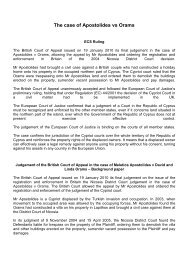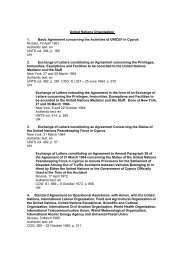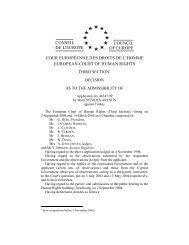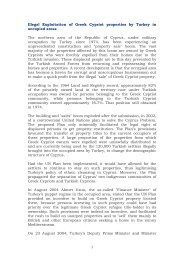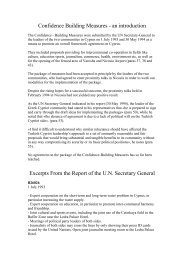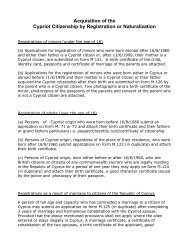CAAG INSIDE ENGLISH 2011_Layout 1.qxd - Ministry of Foreign ...
CAAG INSIDE ENGLISH 2011_Layout 1.qxd - Ministry of Foreign ...
CAAG INSIDE ENGLISH 2011_Layout 1.qxd - Ministry of Foreign ...
You also want an ePaper? Increase the reach of your titles
YUMPU automatically turns print PDFs into web optimized ePapers that Google loves.
AFRICA<br />
EUROPE<br />
10<br />
CYPRUS<br />
Location and Area<br />
Cyprus is a small island <strong>of</strong> 9.251 sq kms (3.572 sq<br />
miles), extending 240 kms (149 miles) from east to<br />
west and 100 kms (62 miles) from north to south. It is<br />
strategically situated in the far eastern end <strong>of</strong> the<br />
Mediterranean (33° E, 35°N), at the crossroads <strong>of</strong><br />
Europe, Africa and Asia, and in close proximity to the<br />
busy trade routes linking Europe with the Middle East,<br />
Russia, Central Asia and the Far East.<br />
Topography<br />
Cyprus has two mountain ranges: the Pentadaktylos<br />
range which runs along almost the entire northern<br />
coast, and the Troodos massif in the central and southwestern<br />
parts <strong>of</strong> the island which culminates in the<br />
peak <strong>of</strong> Mount Olympus, 1.953 m. above sea level.<br />
Cyprus' coastal line is indented and rocky in the north<br />
with long sandy beaches in the south. Between the<br />
two ranges lies the fertile plain <strong>of</strong> Messaoria.<br />
Climate<br />
MIDDLE EAST<br />
Cyprus has a Mediterranean climate: hot dry summers<br />
from June to September and mild, wet winters from<br />
November to March, which are separated by short<br />
Autumn and Spring seasons <strong>of</strong> rapid change in<br />
weather patterns in October, April and May. Sunshine<br />
is abundant during the whole year, particularly from<br />
April to September when the daily average exceeds<br />
eleven hours.<br />
Flora and Fauna<br />
Seventeen percent <strong>of</strong> the island is woodland. The<br />
natural vegetation includes forests <strong>of</strong> evergreen and<br />
deciduous trees, shrubs and flowers. The flora<br />
comprises about 1.800 species, sub-species and<br />
varieties. About 140 or 7% <strong>of</strong> these are endemic to<br />
Cyprus. The Cyclamen (Cyclamen cyprium) has been<br />
declared Cyprus’ national plant while the Golden<br />
Oak (Quercus alnifolia) has become the island’s<br />
national tree.<br />
The fauna <strong>of</strong> Cyprus includes some 7 species <strong>of</strong> land<br />
mammals, 26 species <strong>of</strong> amphibians and reptiles, 365<br />
species <strong>of</strong> birds, and a great variety <strong>of</strong> insects, while<br />
the coastal waters <strong>of</strong> the island give shelter to 197 fish<br />
species and various species <strong>of</strong> crabs, sponges and<br />
echinodermata.<br />
The largest wild animal that still lives on the island is<br />
the Cyprus moufflon, a rare type <strong>of</strong> wild sheep that can<br />
only be found in Cyprus.





